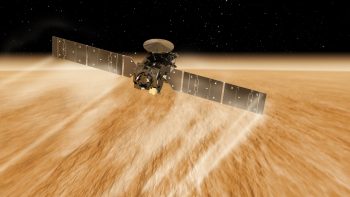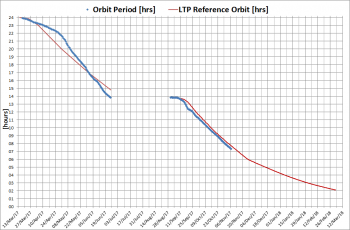Editor’s note: This week’s blog update comes courtesy of TGO Spacecraft Operations Manager Peter Schmitz at ESA’s ESOC mission control centre in Darmstadt, Germany. The ExoMars Trace Gas Orbiter (TGO) has been conducting a complex and challenging aerobraking campaign since March 2017, using the faint drag of Mars’ upper atmosphere to slow it and lower it into its final science orbit, eliminating the need to have carried along hundreds of kilogrammes of fuel on its journey to the Red Planet. Aerobraking is expected to end around March 2018, after which TGO will perform some additional manoeuvres to achieve its final, near-circular, science orbit of about 400 km altitude.

Visualisation of the ExoMars Trace Gas Orbiter aerobraking at Mars. With aerobraking, the spacecraft’s solar arrays experience tiny amounts of drag owing to the wisps of martian atmosphere at very high altitudes, which slows the craft and lowers its orbit. Credit: ESA/ATG medialab
On Friday, 17 November, the flight controllers at ESOC began operations to bring the spacecraft into a new phase of the on-going aerobraking campaign, marking the start of ‘shorter’ orbits. ‘Short’ is considered, somewhat arbitrarily, as when the orbital period (i.e. time needed to complete one orbit) falls below 6 hrs.
Here’s a brief summary of progress to date.
TGO resumed its aerobraking campaign in August after a short break during summer due to conjunction with the Sun (that is, the Sun blocked the line-of-sight signal path between Earth and Mars), which makes for difficulties in communicating with the Red Planet.
Almost a month later, on 19 September, TGO’s operators faced, for the first time, a situation that violated the peak acceleration limits on the spacecraft, which then triggered an autonomous ‘flux reduction manoeuvre.’
During this operation, the propulsion system operated to raise the pericentre height (the point in the orbit where the spacecraft is closest to the planet) by 3 km, so that the next time the spacecraft passed through the atmosphere, the aerodynamic drag was reduced.
This event was quickly ‘recovered’ – which is engineer-speak meaning ‘everything got back to normal’ – so no delay in the overall aerobraking campaign was incurred.
“As of now, TGO aerobraking is on track with respect to our long-term predictions,” says Peter.
“On 8 November, our orbital period was seven hours and eight minutes, while now it is closer to six hours and twenty minutes.”
Solving problems
Another spacecraft anomaly occurred in the Data Handling System in October.
This time, the problem was caused by a corrupted ‘on-board control procedure’ (OBCP), which is a small program responsible for resetting the star tracker after any blinding condition (star trackers are cameras used to help determine the orientation of a spacecraft).
The operations team at ESOC noticed the problem when the autonomous execution of this procedure resulted in a checksum error – basically, an error indicating that a stored bit of data was not the value expected.
The situation was quickly recovered by re-uploading a fresh copy of the small OBCP programme.
However, mission controllers are, by nature, driven to fully understand the complex spacecraft for which they are responsible, and the event kicked off an intense investigation to determine why this anomaly occurred.
After a great deal of sleuthing work, the team found that this particular OBCP had been mistakenly overwritten by another command file, and that this problem could re-occur.
Although it was not a critical issue at the time it was discovered, the same malfunction could potentially overwrite more important command files or on-board control procedures that are required by the spacecraft’s computer for daily flight operations or contingency recovery situations.
“At first, we hypothesised that the failure could have been due to radiation effects on the spacecraft’s mass memory, or due to an on-board feature that corrects memory ‘bitflips’ automatically,” says Johannes Bauer, TGO’s data handling engineer.
Flipping bits
A ‘bitflip’ occurs when a single stored data bit – a 1 or a 0 – randomly flips to the opposite value due to the passage of solar or cosmic radiation through the solid-state memory.
An investigation was launched and Johannes and the TGO team at ESOC worked together with the spacecraft manufacturer, Thales Alenia Space, to define and implement a fix.
“Initially, the problem was mitigated by uploading files in a certain order,” said Spacecraft Operations Engineer Chris White.
However, TAS rapidly coded a new software patch that was successfully tested and validated on the TGO simulator at ESOC and on the avionics test bench – basically, an engineering copy of the spacecraft’s flight control systems and computer – located at a TAS factory in Italy.
“The team is planning to upload the central software RAM patch to the spacecraft in the coming days, which should solve this problem,” says Chris.
Final phase of aerobraking
Despite these and a number of other smaller issues, TGO’s final aerobraking operations have already started and this involves both the space segment (i.e. the spacecraft) and the ground segment (i.e. the systems used on Earth to fly TGO).
This month, the flight control team will set the mission control system into a ‘hot redundant’ configuration – with two identical ground control systems working at the same time providing immediate back-up in case one control system becomes unavailable.
The team will also use an automated system configuration to open and close telemetry and telecommand links1, saving time during ‘live’ operations (when the team are in contact with the spacecraft via a ground station like ESA’s New Norcia station in Australia or Malargüe station in Argentina, or via a NASA deep-space network station) and reducing the chances of human error during delicate manoeuvres.
Time gets tight
From now on, the aerobraking campaign will gradually evolve.
The spacecraft will slow, increasing the height of its pericentre and, consequently, reducing the effect of the atmosphere’s drag on TGO. During this phase, it will orbit around Mars multiple times a day and operations will intensify.
This means that the flight control team and the flight dynamics specialists at ESOC will have to estimate the spacecraft’s orbits and upload new commands daily, instead of every two days as is the case now.
Until the end of aerobraking in March 2018, the daily commanding volume will steadily increase because more and more orbits will be flown per day while the available time to compose and transmit commands to the spacecraft will become tighter – primarily because the ground station contacts, or passes, will be increasingly interrupted whenever the spacecraft passes through the Red Planet’s atmosphere.
Aerobraking on track
As of now, the flight control team expect that the aerobraking campaign will conclude in March 2018, as planned.
However, there are still a few months to go, and unforeseen issues – or another flux reduction manoeuvre – could yet delay aerobraking progress.
“If aerobraking were to be delayed by a week, for example, that would surely affect our routine operations planning, but not so much the overall mission timeline,” says Peter.
The situation, would be different, however if any delay were to last longer.
“The implications are more severe, for example, if we had a delay of a month,” says Peter.
“Then, there would be knock-on effects in ground station scheduling with regard to other missions and flight control team engineer scheduling and assignments, and the start of the routine science and data-relay mission could be noticeably delayed.”
Aerobraking operations require 24-hour/day, 7 days/week ground station coverage, and at the moment TGO are using the two ESA stations mentioned earlier as well as NASA Deep Space Network stations.
“The ground-station booking schedule is agreed with other ESA and NASA missions. If TGO needed to extend its usage of ground stations for the final aerobraking phase, it would have effects on other missions, too, as their science return would be affected and operations need to be re-planned.”
“For now though, we are in good shape and everything is on track, and we’re looking forward to achieving our final science orbit and the start of data gathering and relay at Mars.”
Note: (1) ‘Telemetry’ is the on-board status information that the spacecraft transmits to ground, informing engineers of its current status and conditions, while telecommands are the instructions prepared on ground that are sent up by the flight controllers to tell the spacecraft what it should do.


Discussion: 2 comments
Why are the two Russian ground-stations, Medvezh’i Ozera and Kalyazin, not involved at the moment?
hi very great!